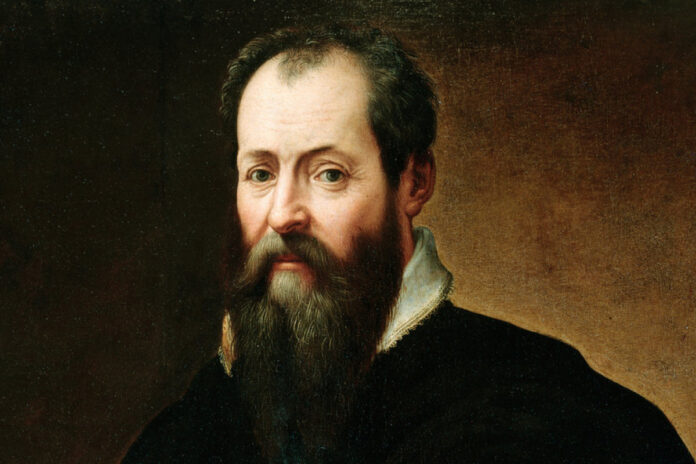Giorgio Vasari is a name that resonates deeply within the annals of art history. As a multifaceted genius of the Italian Renaissance, Vasari’s contributions as a painter, architect, and, most notably, an art historian have left an indelible mark on the cultural landscape of Italy. This article delves into Vasari’s life, his major works, and his legacy, shedding light on his pivotal role in shaping the Renaissance and the study of art.
Early Life and Education
Birth and Early Years
Giorgio Vasari was born on July 30, 1511, in Arezzo, Tuscany. His family, although not wealthy, recognized his talent for drawing at an early age and supported his artistic inclinations. This support led Vasari to Florence, where he would receive his formative education and make significant connections that would shape his career.
Training and Influences
In Florence, Vasari was apprenticed to the renowned artist Andrea del Sarto. This apprenticeship exposed him to the techniques and styles of the Florentine School, which emphasized naturalism, perspective, and anatomical precision. Vasari also studied under prominent artists such as Michelangelo and Raphael, whose influence is evident in his later works.
Painting Career
Early Works
Vasari’s early works demonstrate his technical skill and ability to assimilate the styles of his mentors. One of his first notable commissions was for the church of San Domenico in Arezzo, where he painted “The Annunciation” in 1528. This work, characterized by its clarity of composition and delicate use of color, established Vasari as a promising young artist.
The Sala dei Cento Giorni
One of Vasari’s significant projects was the decoration of the Sala dei Cento Giorni (Hall of One Hundred Days) in the Palazzo della Cancelleria in Rome. Commissioned by Cardinal Alessandro Farnese in 1546, Vasari completed the frescoes in just 100 days, a feat that underscored his efficiency and skill. The frescoes depict scenes from the life of Pope Paul III, showcasing Vasari’s mastery in narrative painting and his ability to handle large-scale compositions.
The Palazzo Vecchio Frescoes
Another major achievement in Vasari’s painting career was the fresco decoration of the Palazzo Vecchio in Florence. Commissioned by Duke Cosimo I de’ Medici, Vasari and his team adorned the walls and ceilings of the palace with grandiose scenes celebrating the history and triumphs of Florence and the Medici family. These frescoes, completed between 1555 and 1572, are notable for their vibrant color, dynamic composition, and intricate detail.
Architectural Contributions
The Uffizi Gallery
As an architect, Vasari’s most famous project is undoubtedly the Uffizi Gallery in Florence. Commissioned by Cosimo I de’ Medici in 1560, Vasari designed the Uffizi as a governmental office complex. The name “Uffizi” itself means “offices.” The building’s long, narrow courtyard, open to the Arno River at one end, creates a striking perspective and is considered a masterpiece of Renaissance architecture. Today, the Uffizi Gallery is one of the most important art museums in the world, housing an unparalleled collection of Renaissance masterpieces.
The Vasari Corridor
Another significant architectural achievement is the Vasari Corridor, an elevated passageway that connects the Palazzo Vecchio with the Palazzo Pitti, crossing the Arno River via the Ponte Vecchio. Constructed in 1565, this corridor was designed to allow the Medici family to move freely and safely between their residences. The corridor’s innovative design and strategic placement reflect Vasari’s architectural ingenuity and his understanding of the Medici’s political needs.
Church of Santa Maria Novella
Vasari also contributed to the design and renovation of several churches in Florence, including the Church of Santa Maria Novella. His work on the church’s façade and interior reflected his ability to blend classical elements with contemporary Renaissance aesthetics, further cementing his reputation as a versatile and skilled architect.
Art Historical Contributions
“Lives of the Most Excellent Painters, Sculptors, and Architects”
Giorgio Vasari’s most enduring legacy, however, lies in his role as an art historian. His seminal work, “Le Vite de’ più eccellenti pittori, scultori, e architettori” (“Lives of the Most Excellent Painters, Sculptors, and Architects”), first published in 1550 and expanded in 1568, is considered the foundation of modern art history. This comprehensive collection of biographies provides invaluable insights into the lives and works of Renaissance artists, including Giotto, Brunelleschi, Leonardo da Vinci, Michelangelo, and Raphael.
Importance of “Lives”
The “Lives” is not merely a compilation of biographies but a critical analysis of the development of art from the Middle Ages to Vasari’s time. Vasari introduced the concept of artistic progress, emphasizing the evolution of techniques and styles. His work highlighted the importance of individual genius and the role of patronage in the flourishing of art. Despite its biases and occasional inaccuracies, “Lives” remains an essential resource for understanding the Renaissance and the artists who shaped it.
Influence on Art History
Vasari’s work established a framework for art historical writing that has influenced generations of scholars. His emphasis on first-hand accounts, critical analysis, and the contextualization of artists within their historical and cultural milieus set a standard for future art historians. “Lives” continues to be referenced and studied, underscoring Vasari’s pivotal role in the historiography of art.
Major Works and Contributions
The Last Supper
One of Vasari’s significant paintings is “The Last Supper,” completed in 1546 for the refectory of the Convent of Monte Oliveto in Naples. This work, notable for its dynamic composition and vivid color, demonstrates Vasari’s ability to handle complex narratives and large-scale frescoes. Although it has suffered damage over the centuries, “The Last Supper” remains an important example of Vasari’s skill as a painter.
The Allegory of the Immaculate Conception
Commissioned for the church of San Francesco in Arezzo, “The Allegory of the Immaculate Conception” (1541) is another noteworthy work by Vasari. This painting, depicting the Virgin Mary surrounded by symbols of purity and divine grace, exemplifies Vasari’s talent for allegorical compositions. The use of vibrant colors and intricate details highlights his mastery of the Mannerist style.
Vasari’s Influence and Legacy
The Spread of the Mannerist Style
Vasari played a crucial role in the spread and popularization of the Mannerist style, characterized by its artificiality, elegance, and emphasis on technical virtuosity. Through his works and writings, Vasari promoted the aesthetic ideals of Mannerism, influencing artists across Italy and beyond. His emphasis on style and technique helped to shape the artistic trends of the late Renaissance and early Baroque periods.
Preservation of Renaissance Art
As an art historian, Vasari’s efforts in documenting and preserving the works of Renaissance artists have had a lasting impact. His detailed descriptions and critical evaluations of artworks have provided invaluable insights for scholars, conservators, and art lovers. Vasari’s work helped to preserve the memory of the Renaissance and its artistic achievements, ensuring that future generations would continue to appreciate and study this pivotal period in art history.
The Vasari Legacy
Giorgio Vasari’s legacy extends beyond his artistic and architectural achievements. His work as an art historian laid the groundwork for the systematic study of art, and his “Lives” remains a cornerstone of art historical scholarship. Vasari’s contributions have left an indelible mark on the cultural heritage of Italy and the broader history of Western art.
Personal Life and Character
Relationships and Personality
Vasari was known for his affable personality and ability to cultivate relationships with influential patrons and fellow artists. His close ties with the Medici family, particularly Cosimo I de’ Medici, provided him with numerous prestigious commissions and opportunities. Vasari’s collaborative nature and ability to work within the complex political and social landscapes of his time contributed to his success and enduring legacy.
Death and Commemoration
Giorgio Vasari died on June 27, 1574, in Florence. He was buried in the Church of Santa Maria della Pieve in Arezzo, his hometown. His epitaph, reflecting his contributions to art and architecture, reads: “To Giorgio Vasari, an incomparable man, for his excellence in painting, architecture, and the writing of lives, this sepulcher is dedicated.”
FAQs
1. What are some of Giorgio Vasari’s most famous works?
Some of Giorgio Vasari’s most famous works include the frescoes in the Sala dei Cento Giorni, the decoration of the Palazzo Vecchio, and the design of the Uffizi Gallery.
2. How did Giorgio Vasari influence art history?
Giorgio Vasari influenced art history through his seminal work, “Lives of the Most Excellent Painters, Sculptors, and Architects,” which provided critical biographies and analyses of Renaissance artists and established a framework for art historical writing.
3. Where can Giorgio Vasari’s works be seen today?
Giorgio Vasari’s works can be seen in various locations, including the Uffizi Gallery and Palazzo Vecchio in Florence, and the Convent of Monte Oliveto in Naples.
4. What was Giorgio Vasari’s role in the development of the Mannerist style?
Giorgio Vasari played a crucial role in the development and spread of the Mannerist style through his paintings, architectural designs, and writings that emphasized technical virtuosity and stylistic elegance.
5. How did Giorgio Vasari’s relationships with patrons influence his career?
Giorgio Vasari’s relationships with influential patrons, particularly the Medici family, provided him with numerous prestigious commissions and opportunities, significantly shaping his career and contributions to art and architecture.
Conclusion
Giorgio Vasari’s multifaceted contributions to the world of art as a painter, architect, and art historian are unparalleled. His innovative paintings, architectural designs, and seminal work, “Lives of the Most Excellent Painters, Sculptors, and Architects,” have left an indelible mark on the cultural landscape of Italy and the broader history of art. Vasari’s legacy continues to inspire and inform, ensuring that his impact on the Renaissance and the study of art endures for generations to come.
Giorgio Vasari’s life and works represent a transformative period in art history. His contributions as a painter, architect, and art historian have left a lasting legacy that continues to inspire and inform the study and appreciation of Renaissance art.

